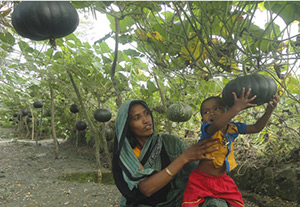
The Farmer Nutrition School (FNS) is a community forum to teach and mentor household members to improve the production and consumption of high-quality diets rich in micronutrients for pregnant and lactating women and children ages 6-24 months. The focus of the community intervention is Homestead Food Production (HFP) for the promotion of nutrient-dense vegetables such as sweet gourd, bottle gourd, knolkhol, radish, red amaranth, stem amaranth, kangkong, Indian spinach, okra, bitter gourd, tomato, papaya, ash gourd, country bean, and yard loing bean, as well as the promotion of animal source foods (fish, poultry, and eggs).
The FNS integrates agricultural extension and adult participatory learning to enhance the capacity of households to make well-informed crop management decisions. Usually the sessions continue throughout a cropping season and give each participant a chance to observe and demonstrate their knowledge through improved agronomic practices in their own fields.
The FNS methodology was originally developed in conjunction with the Integrated Pest Management (IPM) program with the objective of helping farmers understand the ecological interactions in their crop production system, and to enable them to manage these interactions by making use of the natural resilience of the system and limiting the disturbing influence of outside factors. The FNS started with rice in order to promote the use of biological and integrated pest management as an alternative to chemical control, but has gradually been applied to other crops, livestock, fisheries, non-agricultural production, general livelihood issues and environmental management. In SPRING/Bangladesh, the curriculum of agricultural FNS has broadened to include ENA/EHA in gardening, poultry and fish production sessions.
The Essential Nutrition Actions (ENA) framework delivers a set of evidence-based interventions to improve nutritional status during the critical 1,000 days from pregnancy through the first two years, targeting pregnant and lactating women and their young children. The framework defines the right action to be taken by the right person at the right time in the life cycle. This session guide provides a set of tools to be used at the community level to help translate this framework more effectively, by identifying and making the most of contacts within this system to promote and support improved nutrition practices.
The ENA framework promotes a “nutrition through the life cycle” approach, addressing adolescent and women’s nutrition during pregnancy and lactation, optimal breastfeeding and complementary feeding practices, nutritional care of sick and malnourished children, and the control of anemia, vitamin A and iodine deficiencies.
The Essential Hygiene Actions (EHA) delivers a set of evidence-based practices for food hygiene and handwashing, and addresses the need for a simple water source (tippy tap) around the cooking area. The actions include: promotion of safe drinking water (such as chlorine dispensers at water points), handwashing at five critical occasions (after defecation, after cleaning a child who has defecated, before preparing food, before feeding a child, and before eating), safe disposal of feces, safe storage and handling of food, use of latrines and promotion of open defecation-free communities, and creating barriers between toddlers, soiled environments and animal feces.
Implementing ENA/EHA in the agricultural sector provides several opportunities to promote specific nutrition actions for families, particularly for mothers and fathers with children under two years:
- agricultural extension agents, farmer networks and farmer nutrition schools; and
- agriculture platforms such as agriculture production input provision, veterinarians, and financial services and markets.
For maximum nutritional impact on vulnerable groups, gender considerations must be elucidated at each step. Similarly, the environmental, socio-cultural and enabling factors in each setting must be taken into consideration. SPRING has divided this guide into three modules: vegetable gardening, native chicken rearing and pond fish culture.
Agricultural officers and DANIDA agricultural experts were involved in developing and field-testing this manual, which is a project of the GoB agricultural departments. This guide was developed to help community members (both women and men) and community groups start and improve their technical understanding in the following areas:
- Vegetable farming, by improving the method of selecting sites, species and crops, preparation of beds and planting pits for planting vegetables, and through successful farm management;
- Rearing local chickens through improved semi-scavenging methods applying the techniques of using the improved hazol (brooding nest), early separation of chicks from the broody hen, using two to four layers of hygienic poultry shed and rearing chicks in cages or the multi-layer poultry shed, and ensuring balanced feeding and bio-security;
- Fish farming in homestead base ponds using semi-intensive composite carp culture techniques incorporating the small indigenous species, which have high nutritional values.
This guide incorporates ENA and EHA in each session to encourage families to adopt improved practices in health and nutrition as well as HFP, when they have pregnant women and/or children less than two years of age (the first 1,000 days). The guide was developed by SPRING/Bangladesh and has been used since 2012 as part of the implementation work being done in Bangladesh.
Objectives
By the end of all FNS training sessions, participants will be able to:
- Understand key elements to improve vegetable farming, rear local chickens and manage fish farming;
- Understand how to improve nutrition and hygiene practices in their households; and
- Practice all the steps of HFP: vegetable farming, rearing local chickens and/or managing fish farming.
Participants
These FNS sessions are suitable for all types of community members. For SPRING, the modules/sessions are tailored to households with pregnant and lactating women and children less than two years of age.
To access the guide, click the download link (above).